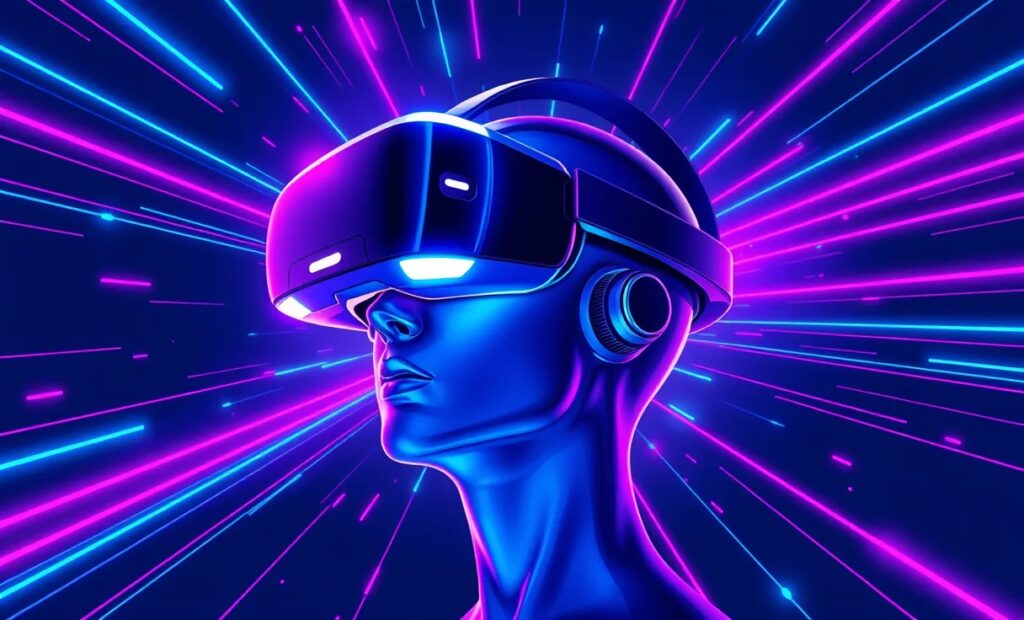
What’s the next big thing? Wouldn’t it be good to know? AI can .. By analyzing vast amounts of data, AI is uncovering trends and fueling innovations across industries.
Here’s how it works and why it matters.
The Power of AI in Trend Prediction
How AI Analyzes Data to Spot Patterns
AI tools, like machine learning models, process massive datasets to identify trends that human analysts might overlook.
For instance, AI sifts through social media chatter, news articles, and market reports in real time. This allows it to detect subtle signals, such as changes in consumer preferences or emerging market opportunities.
The key is in data-driven insights. Unlike traditional methods, AI recognizes correlations, helping companies predict outcomes with surprising accuracy.
Real-Time Monitoring for Industry Shifts
With AI, businesses can monitor shifts in their industry as they happen. This agility is priceless in fast-paced markets like technology and fashion.
For example, AI-powered tools like Google Trends or specialized platforms such as Brandwatch give organizations a competitive edge. They flag early signs of disruption, enabling proactive strategies.
Personalization in Predictive Analytics
AI doesn’t just predict trends; it tailors them. Algorithms like collaborative filtering refine their insights based on user behavior, offering personalized trend reports for specific industries or demographics.
This personalization makes AI a valuable asset for e-commerce giants like Amazon, where knowing customer preferences directly drives revenue.

AI’s Role in Shaping Future Innovations
Idea Generation Through AI Algorithms
AI accelerates brainstorming and innovation by suggesting ideas derived from historical data.
Take companies like IBM, which use AI-driven tools like Watson to explore unexplored domains. These systems recommend solutions and even predict which ones will be most impactful.
Driving Research and Development
AI is revolutionizing R&D by streamlining processes. For instance, pharmaceutical companies use AI to speed up drug discovery, cutting years off development timelines.
Startups like Insilico Medicine are prime examples of AI identifying potential cures by analyzing genetic data faster than ever before.
Collaborating with Human Creativity
Rather than replacing humans, AI enhances creative thinking. Artists and engineers use tools like DALL-E to co-create, merging machine precision with human imagination.
This collaboration fuels innovations in unexpected areas, from architectural design to entertainment content.
Emerging Trends Spotted by AI
Sustainability and Green Tech
AI has pinpointed sustainability as a core focus for the future. Businesses are leveraging AI to optimize energy usage and reduce emissions.
For instance, AI-driven smart grids predict energy demands more accurately, reducing waste while supporting renewable energy sources.
Remote Work and Virtual Collaboration
The shift to remote work has spurred innovations in collaboration technologies. AI tools now enhance virtual meetings, from automated note-taking to predictive scheduling.
Platforms like Zoom AI Companion are setting benchmarks in streamlining remote interactions.
Industries Transforming with AI’s Influence
Healthcare: Precision Medicine and Diagnostics
AI has ushered in a new era of precision medicine, tailoring treatments to individual patient profiles.
Algorithms analyze medical histories, genetic data, and real-time health metrics to provide accurate diagnoses and predict potential health risks. For example, tools like DeepMind’s AlphaFold have revolutionized protein folding research, paving the way for innovative drug treatments.
Robotics powered by AI is also transforming surgery. Systems such as da Vinci Surgical Robots assist surgeons with precision and efficiency, reducing recovery times for patients.
Finance: Smarter Risk Management
The finance sector is harnessing AI to improve risk assessment, fraud detection, and investment strategies.
AI models detect irregularities in transaction patterns, catching fraudulent activity before it escalates. Tools like Kensho are empowering analysts to make data-driven decisions, whether for stock predictions or portfolio optimization.
Moreover, robo-advisors like Betterment and Wealthfront personalize investment plans using algorithms, making sophisticated financial advice accessible to everyone.
Retail: Hyper-Personalized Shopping
Retailers are redefining customer experiences with AI-powered recommendation systems.
AI tools analyze browsing and purchase behaviors, curating products that align with individual tastes. Think of platforms like Shopify and Amazon, where AI drives product suggestions, pricing strategies, and even supply chain efficiency.
AI chatbots, like Zendesk AI, also enhance customer support, providing 24/7 service tailored to specific queries.
Education: Adaptive Learning Systems
AI is revolutionizing education with adaptive learning platforms that adjust to students’ unique learning speeds and styles.
Tools like Knewton and Duolingo use AI to personalize lesson plans, offering targeted support where students struggle. This ensures a tailored learning journey that maximizes retention and engagement.
Additionally, AI is automating administrative tasks such as grading, freeing up educators to focus on teaching and mentorship.
Transportation: Autonomous Vehicles and Logistics
The transportation industry is undergoing a seismic shift with AI-driven technologies.
Autonomous vehicles, spearheaded by companies like Tesla and Waymo, are transforming how people travel. These cars use machine learning to interpret road data and adapt in real-time, making journeys safer and more efficient.
In logistics, AI optimizes routes and predicts delivery times with tools like FedEx’s SenseAware, reducing delays and improving efficiency across supply chains.

Ethical Challenges of AI in Trendspotting
Bias and Fairness in AI Models
One significant concern is the presence of bias in AI algorithms, which can perpetuate inequality.
For example, facial recognition software has faced criticism for inaccuracies in identifying individuals from diverse demographics. Ensuring fairness requires diverse datasets and transparent algorithms.
Data Privacy and Security Risks
AI relies on massive amounts of personal data, raising questions about data protection.
Tools like GDPR compliance frameworks aim to ensure organizations handle sensitive information responsibly. Balancing innovation with privacy safeguards remains a constant challenge.
Job Displacement vs. Creation
AI’s ability to automate tasks has sparked debates about job displacement.
However, it’s also creating new roles in fields like data science, AI ethics, and robot maintenance. The focus should be on reskilling workers to thrive in AI-driven industries.
The Future of AI-Driven Innovation
Interdisciplinary Applications on the Rise
The next wave of AI innovation will likely involve interdisciplinary solutions, merging insights from fields like biology, physics, and computer science.
Imagine AI creating materials with custom properties for medical implants or eco-friendly packaging—blending fields to solve global challenges.
AI and Augmented Reality (AR) Synergy
The integration of AI with AR is reshaping entertainment, retail, and even education.
For example, AR-enhanced AI tools allow users to virtually “try on” clothes or furniture, bridging the gap between online and in-store experiences.
Universal AI Assistants
AI assistants, like ChatGPT or voice-activated devices, will evolve into multi-functional tools, capable of handling everything from scheduling to creative brainstorming.
These advancements promise a future where AI doesn’t just assist—it anticipates and enhances every aspect of human life.
AI’s journey has just begun, and the possibilities are endless. By embracing these changes, we can unlock a future that’s smarter, more sustainable, and brimming with opportunities.
The Synergy Between AI and Human Potential
Enhancing Human Decision-Making
AI serves as a powerful ally in decision-making, offering insights grounded in data analysis.
In complex fields like urban planning or global logistics, AI systems model countless scenarios, allowing leaders to make informed choices. For instance, AI-powered dashboards help governments optimize resources during crises, from pandemics to natural disasters.
By combining AI precision with human intuition, we unlock the ability to tackle challenges on an unprecedented scale.
Empowering Creativity with AI Tools
Far from replacing creativity, AI tools enhance it. Musicians use AI to compose harmonies, while writers generate ideas with algorithms like GPT.
Platforms like Runway AI allow designers to create visuals in minutes, freeing up time for more strategic work. The result? AI acts as a co-creator, sparking new levels of ingenuity across industries.
Accelerating Scientific Discoveries
AI’s ability to process complex datasets is fueling breakthroughs in science.
From discovering exoplanets with machine learning to mapping genomes for rare diseases, AI tools are accelerating progress. Organizations like NASA and CERN rely on AI to sift through vast data troves, making the impossible seem routine.

Practical Steps to Leverage AI for Trendspotting
Start with Clear Objectives
The journey to leveraging AI begins with a crystal-clear understanding of your goals.
Are you aiming to identify consumer behavior shifts, optimize supply chains, or monitor market trends? Clear objectives not only help in choosing the right tools but also streamline data collection and analysis.
For instance, a retail business looking to predict fashion trends might focus on analyzing social media hashtags, customer reviews, and purchase data. On the other hand, a tech startup might prioritize patent filings and research publications.
Action Tip: Draft a roadmap outlining what trends you want to uncover, their potential business impact, and how AI insights will be applied.
Leverage the Right AI Tools and Platforms
Choosing the right AI tools is critical for actionable trendspotting.
Here are some categories of tools and their use cases:
- Predictive Analytics: Platforms like RapidMiner or SAP Analytics Cloud analyze historical data to forecast trends.
- Natural Language Processing (NLP): Tools like Lexalytics or MonkeyLearn extract insights from text data, including customer reviews, social media, and surveys.
- Visual Data Analysis: Tools like Tableau or Google Data Studio transform data into easy-to-understand visuals, highlighting trends at a glance.
Each tool offers unique strengths, so aligning your platform with your objectives ensures a smoother path to uncovering relevant trends.
Action Tip: Test multiple platforms with sample data to identify which delivers the most valuable insights for your industry.
Invest in High-Quality Data Collection
The foundation of any effective AI model is data quality. Poor or biased data leads to flawed predictions, rendering insights unreliable.
- Internal Data Sources: Ensure data from your CRM, website analytics, or ERP systems is clean, complete, and up-to-date.
- External Data Sources: Use APIs and data aggregators like Quandl or Statista to gather market intelligence.
AI thrives on diverse datasets. Combining internal and external sources enhances the breadth and depth of trend analysis.
Action Tip: Regularly audit your datasets for gaps, anomalies, or biases. This ensures consistent, reliable AI outputs.
Integrate AI with Human Expertise
AI identifies patterns, but human expertise interprets their relevance and context.
A trend that looks promising on paper might not align with your company’s brand or capabilities. In these cases, collaboration between data scientists and business strategists ensures that insights are actionable.
For example, AI might flag a rise in sustainable packaging as a trend. A marketing team could then evaluate whether this aligns with their target audience and logistics team capabilities.
Action Tip: Create cross-functional teams to analyze AI insights. A mix of technical and non-technical perspectives ensures well-rounded strategies.
Monitor and Refine Your AI Models
AI systems evolve with time and need regular refinement to remain effective.
Market conditions change, and trends shift, meaning AI models trained on older data might miss emerging developments. Regular retraining and updating models ensures they stay relevant.
- Feedback Loops: Continuously feed new data back into the model to refine its predictions.
- Performance Reviews: Use metrics like accuracy, precision, and recall to measure model performance over time.
Action Tip: Schedule quarterly reviews of your AI systems to ensure they adapt to changing market dynamics.
Conclusion: Unlocking Tomorrow with AI
AI is no longer just a tool—it’s a game-changer for identifying trends and driving innovations. By embracing AI responsibly, businesses and individuals can turn possibilities into realities. The key lies in collaboration: between humans and machines, ethics and ambition, and today’s potential and tomorrow’s vision.
FAQs
Is AI trendspotting relevant for small businesses?
Absolutely. AI tools are scalable and can be tailored to fit the budget and needs of small businesses.
For example, a local café can use AI-driven sentiment analysis to understand customer preferences by analyzing Google reviews. Similarly, a boutique clothing store might employ predictive analytics to decide which styles to stock based on regional shopping data.
AI levels the playing field, allowing small businesses to compete effectively with larger players.
Can AI replace human analysts in trendspotting?
AI complements human analysts but doesn’t replace them.
While AI excels at processing data and identifying patterns, human intuition and industry knowledge are crucial for interpreting insights. For example, AI might predict a rise in vegan food demand, but understanding regional taste preferences or cultural nuances would still require a human touch.
The best results come from a combination of AI-powered insights and human expertise.
How do I choose the right AI tools for trendspotting?
Selecting the right AI tools depends on your objectives and industry.
For example, a fashion retailer might benefit from NLP tools like Lexalytics to analyze social media trends, while a logistics company could use predictive analytics platforms such as Power BI to optimize supply chains.
Key factors to consider include ease of integration, data compatibility, and the specific insights you need to achieve your goals.
What are the risks of relying on AI for trends?
One risk is data bias, which can lead to skewed predictions.
For example, if an AI model only analyzes data from one region, it might overlook global trends. Another concern is over-reliance; businesses might act on AI insights without considering their feasibility or relevance.
Mitigating these risks involves combining AI insights with human judgment and ensuring the data used is diverse and representative.
How often should AI models be updated for trendspotting?
AI models should be updated regularly to remain effective.
For instance, a model predicting seasonal shopping trends might need updates after significant shifts in consumer behavior, such as those caused by a global event or a new industry regulation.
Frequent updates ensure the AI adapts to changing conditions, providing more accurate and actionable insights.
How does AI ensure predictions are accurate?
AI achieves accuracy by analyzing vast datasets and using advanced algorithms to find patterns.
For example, AI models are validated through historical testing, where they compare predictions with real-world outcomes. Continuous learning and feedback loops further refine predictions. A system predicting real estate trends might analyze years of housing market data, adjusting its insights as new data emerges.
Ensuring data quality and diversity is vital for maintaining accuracy.
What are examples of AI in trendspotting for e-commerce?
AI powers trendspotting in e-commerce by analyzing customer behavior and market dynamics.
- Dynamic Pricing: Tools like Revionics adjust prices based on demand and competition.
- Personalized Recommendations: Amazon’s recommendation engine uses AI to suggest products based on browsing history.
- Trend Alerts: AI detects rising demand for specific categories, such as the sudden popularity of smart home devices.
These capabilities allow e-commerce brands to stay ahead of the curve.
Can AI predict trends in real time?
Yes, AI excels at real-time trendspotting by processing live data streams.
For instance, tools like Brandwatch monitor social media mentions in real time, identifying viral topics or consumer sentiment shifts. Similarly, financial firms use AI to analyze live stock market data, detecting trends that guide trading decisions.
Real-time AI insights are particularly valuable in fast-paced industries like technology, fashion, and finance.
How can small teams implement AI for trendspotting?
Small teams can implement AI for trendspotting by starting small and scaling up.
- Use accessible platforms like Google Trends for basic trend insights.
- Leverage cloud-based tools like Zoho Analytics, which require minimal technical expertise.
- Partner with AI consultants or freelancers for specific projects, such as setting up chatbots or predictive models.
Focus on cost-effective tools that integrate seamlessly with existing workflows.
How does AI spot cultural or societal trends?
AI identifies cultural and societal trends by analyzing sources like social media, blogs, and news.
For instance, during the pandemic, AI detected increased discussions about mental health, leading brands to launch products targeting self-care and wellness.
By combining sentiment analysis with geographic and demographic insights, AI uncovers trends reflecting cultural shifts and preferences.
What role does machine learning play in trendspotting?
Machine learning (ML) forms the backbone of AI in trendspotting by enabling systems to learn and improve over time.
ML algorithms analyze historical data to identify patterns, then use those patterns to make predictions. For example, an ML model might forecast travel trends by evaluating flight bookings, hotel reviews, and seasonal preferences.
Over time, these systems become more accurate, adapting to changes in consumer behavior or external factors.
How does AI manage seasonal trends?
AI manages seasonal trends by analyzing cyclical patterns in data.
For example, AI tools in retail might predict increased demand for winter coats based on past sales, weather forecasts, and fashion trends. In agriculture, AI analyzes planting and harvest schedules to forecast commodity prices.
These insights allow businesses to plan inventory, marketing, and logistics more effectively.
Resources
To successfully integrate AI into your trendspotting strategy, you need the right tools, platforms, and educational materials. Here’s a curated list of resources to help you get started and stay informed.
AI Tools for Trend Analysis
- Google Trends
A free tool for tracking search term popularity over time. Great for identifying early shifts in consumer interests.
Website: Google Trends - Brandwatch
Ideal for monitoring social media trends and customer sentiment in real time. Excellent for marketing and brand management.
Website: Brandwatch - Tableau
A data visualization tool that transforms raw data into interactive dashboards, highlighting patterns and trends.
Website: Tableau - RapidMiner
Provides predictive analytics capabilities, helping businesses identify future trends through historical data analysis.
Website: RapidMiner - Lexalytics
Specializes in Natural Language Processing for analyzing unstructured text data, such as reviews or social media posts.
Website: Lexalytics - IBM Watson Studio
A comprehensive platform offering AI and machine learning tools for advanced trendspotting across industries.
Website: IBM Watson Studio
Educational Resources and Courses
- Coursera: AI for Everyone (by Andrew Ng)
A beginner-friendly course that explains AI concepts and their practical applications across industries.
Website: AI for Everyone - edX: Artificial Intelligence MicroMasters Program
Offers a deep dive into AI fundamentals and trendspotting techniques, with certifications for professionals.
Website: AI MicroMasters - Udemy: Data Science and Machine Learning Bootcamp
A hands-on course covering machine learning models and data analysis for trendspotting.
Website: Udemy Data Science Bootcamp
Industry Reports and Insights
- McKinsey & Company: AI and Analytics
Regularly publishes in-depth reports on how AI transforms industries and its role in spotting trends.
Website: McKinsey AI Insights - Deloitte Insights: The AI Dossier
Focuses on practical applications of AI in trend forecasting and innovation.
Website: Deloitte AI Insights - Gartner: Emerging Technology Trends
Offers reports and predictions on tech trends across sectors, guided by AI-powered analysis.
Website: Gartner Reports